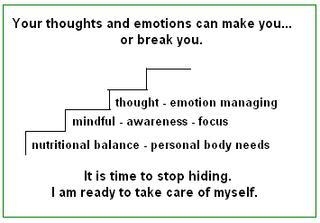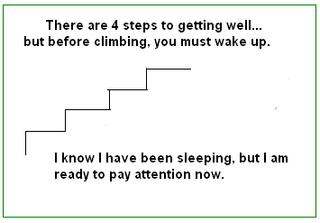
Hopefully you can read the above small print, but if you cannot, I'm going to repeat the most important statement there.
Sugar is the underlying addiction to all addictions. This isn't something that I made up, but well documented by professionals and researchers in this field. Take the time to notice someone addicted to one of the substances above and look for the connecting addictions. I'm sure you will find them. I don't think that I've ever had an addicted individual in my practice who hasn't been around the block with at least one or two of these.
I've had issues with sugar addiction since I've been a young child. In truth, it's only been better over the last fifteen years when I came to design the 4 steps for managing disorderly eating. They have literally saved my life many times over. I was very ill from my eating issues for several decades, although their many aspects were never pinpointed as the reason for my variety of illnesses. All came to light in a series of serendipitous happenings.
Being an RN, I lived under the belief that my eating habits were quite good. Certainly I realized that I liked junk food and sugar, but never thought very much about it. I always had a huge appetite, and even though I always seemed to be hungry, it never dawned on me that there was anything odd about that. For me, I simply considered this
being unlucky, accepting that I'd probably be on a diet of some sort forever, and most likely would never be a size 6. In fact, I often laughed at my perceived dilemma, never realizing that I was finding humor in something that was ruining my quality of life and actually had a potential for killing me. As I look back, it is amazing how out of touch I was with myself and the real truth about my disorderly eating.
I am reminded about this every day in my private practice, as well as when working online with my discussion groups. You can check those out at
http://www.sugar-addiction.comhttp://www.hypnosis-audio.comPatients come to see me to manage their addictions or to unravel their messy lives. As I go through their personal assessment, I'm reminded of myself over and over. Some individuals are very ill, much of it stemming from their undisclosed disorderly eating. I keep asking myself, "how do we get so sick without knowing why? What's missing from our general education? Why didn't my parents know how to take care of me?" I'm sure my very own children are asking the same questions about how I fed them. Both of my sons have had addiction issues, and as I look back to some of the things I allowed in my shopping card, I feel so very bad.
The other day I read an article in the Herald Tribune about how parents are getting tired of trying to get their children to eat healthy foods. These parents are burned out in their own lives, and when they come home they simply don't want to go through what it takes to implement changes. Well....I know what that feels like. However, it is our job as parents to be responsible. It's different when you don't know, but when you do, I can't imagine not pushing forward for what will make your children's life safer and healthier in the future.
I tend to think that parents
still do not understand what happens inside the body when the food intake is not what the body and mind needs. I find this very frequently in my office practice and when counseling parents. I have to keep emphasizing that these are not small, unimportant issues. They are, indeed, major and can lead to some very deleterious outcomes in the future, major addictions included.
Somehow I would like to think that if parents were educated in the seriousness outcomes, they would be more willing to make the effort. However, perhaps I'm having pipe dreams. I remember one little patient of mine who had trichotillomania. She didn't have a hair in her head, nor an eyelash in place. She came to my office clutching a little bag of candy. When I interviewed her mother, she told me that she "herself" ate sugar out of the sugar bowl and consumed at least six cans of regular cola per day. While she wanted her child to stop pulling her hair out, she was not willing to change her role-modeling, nor to wean her child off of the candy. She preferred to stay in complete denial about the effects of sugar on obsessive compulsive disorders, such as that of her daughter. What was especially interesting to me was the look of fright on her face when I suggested that she also stop her
sugaring because of the dangers it also presented to her own mind and body. If you are addicted, or know someone who is addicted, I'm sure you do recognize this feeling and/or look.
When I encountered my earlier mentioned serendipitous events, I learned that I would have to change each and every one of my eating behaviors. I was stunned. Part of me was delighted to find the culprit and to feel better, but the other part wanted nothing to do with it. That, as I mentioned before, was/is my child-self. She adores being undisciplined in relation to food and doesn't particularly care for regular meals, nor protein or even vegetables. She was a white flour, white rice, white potatoe, refined food junkie, so I do know what it means to change. She loved caffeine, food and sugar. Fat, salt, and sugar !!
I tell this to my patients and readers. While the journey was/is difficult, the rewards are absolutely incredible, surpassing anything I could have ever imagined.


